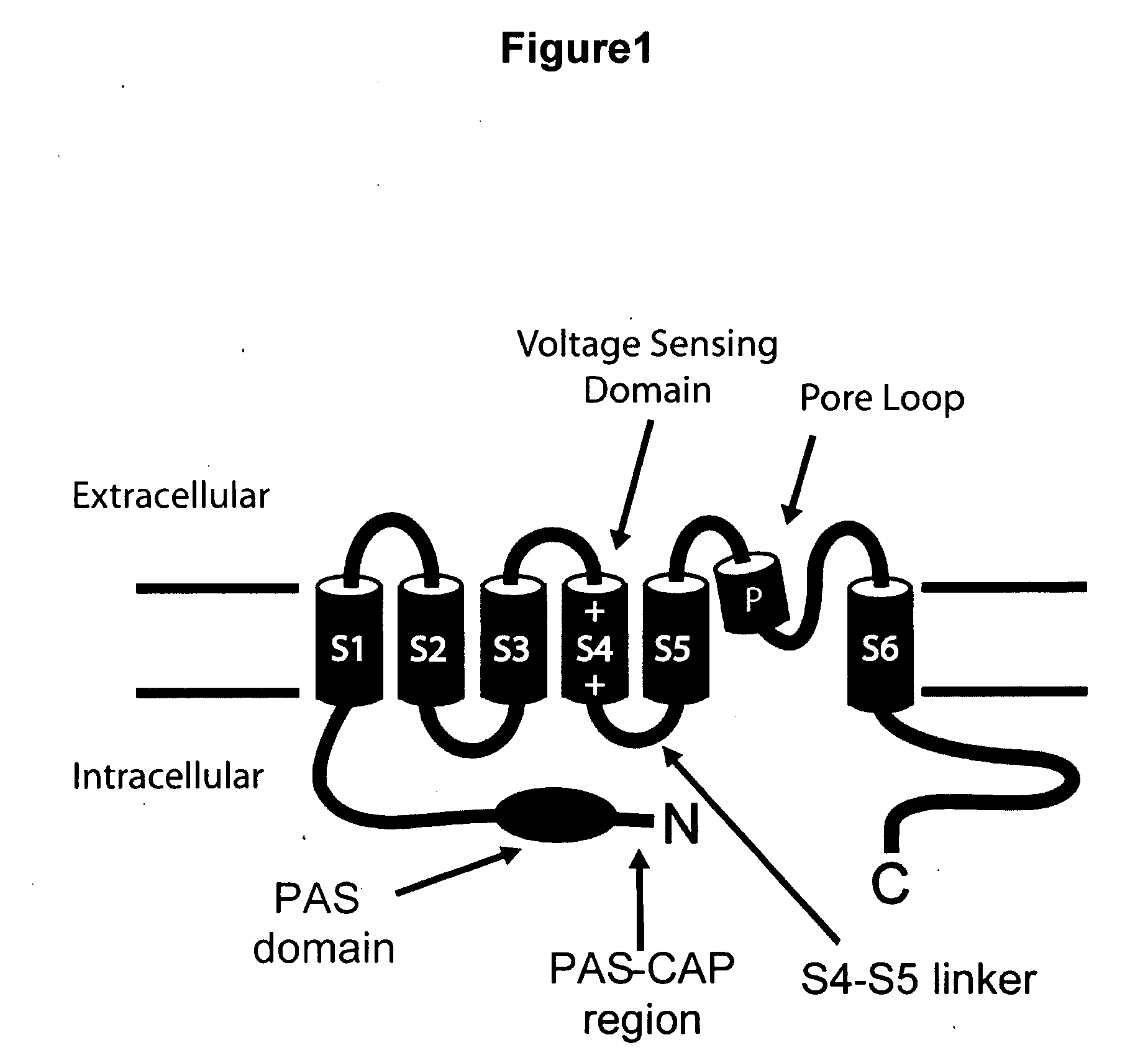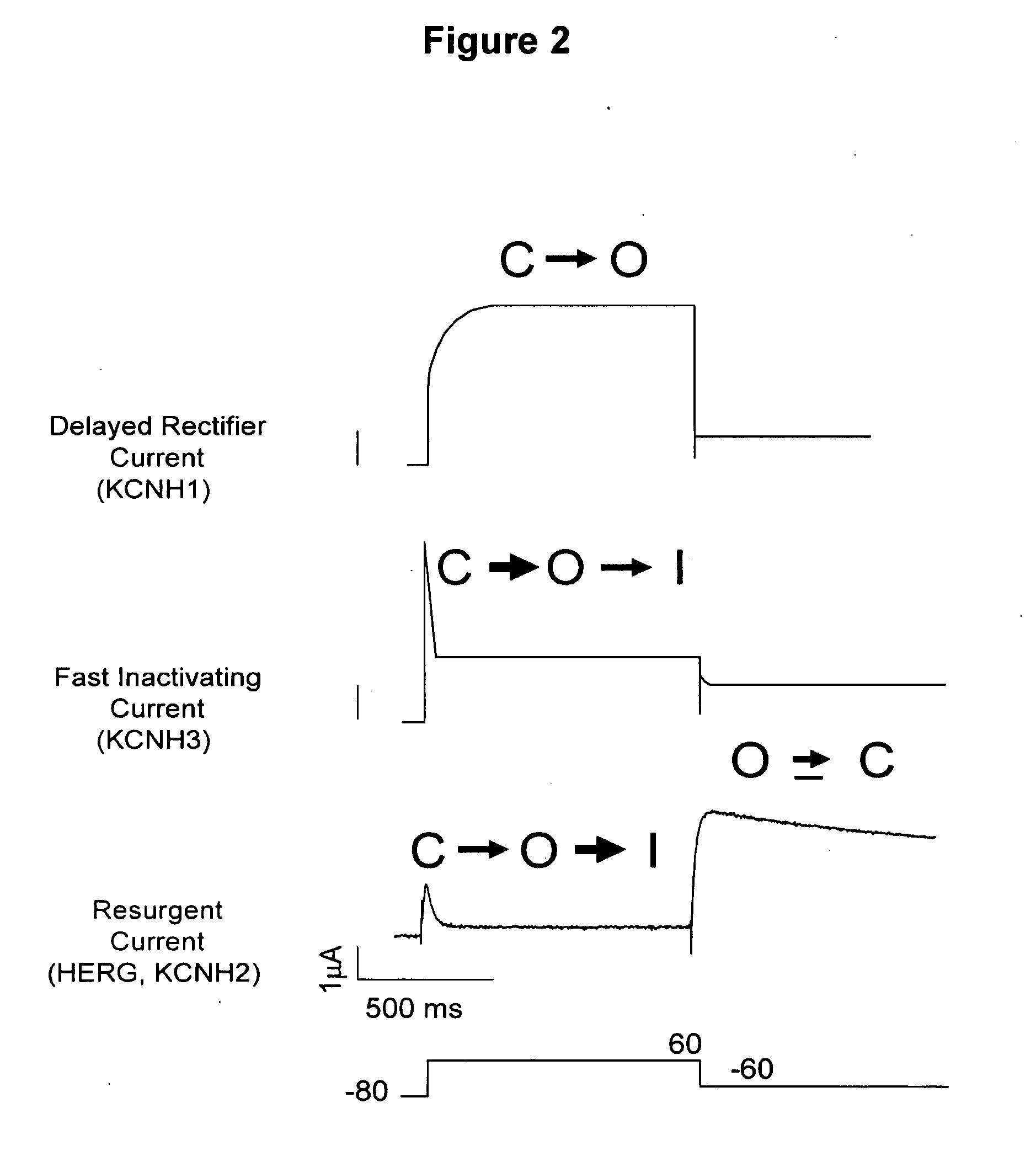ERG-1 Peptides and Polynucleotides and Their Use in the Treatment and Diagnosis of Disease
a technology of erg-1 and erg-1, which is applied in the field of erg-1 peptide and polynucleotide fragments, can solve the problems of synchronization, change of action potential waveform, and/or propagation
- Summary
- Abstract
- Description
- Claims
- Application Information
AI Technical Summary
Benefits of technology
Problems solved by technology
Method used
Image
Examples
example 1
Materials and Methods
[0125]The enhanced cyan fluorescent protein (eCFP) and Citrine clones are described by (Griesbeck, O. et al. (2001) “Reducing The Environmental Sensitivity Of Yellow Fluorescent Protein. Mechanism And Applications,” J. Biol. Chem. 276:29188-29194; Miyawaki, A. et al. (1997) “Fluorescent Indicators For Ca2+ Based On Green Fluorescent Proteins And Calmodulin,” Nature 388:882-887). HERG channels fused to fluorescent proteins, site-directed point mutations and deletion mutations were made using an overlapping PCR strategy and confirmed with DNA sequencing. HERG channel cDNA's were subcloned into a modified pGEMHE vector for heterologous expression. RNA was transcribed with the mESSAGE mACHINE kit (Ambion, Austin, Tex.) and injected with a micropipette into Xenopus oocytes. Oocytes were prepared as described elsewhere (Herzberg, I. M. et al. (1998) “Transfer Of Rapid Inactivation And E-4031 Sensitivity From HERG to M-EAG Channels,” J. Physiol. 511(1)...
example 2
HERG-1a N-Terminal Domain is Capable of Rescuing Slow Deactivation Gating in HERG Channels
[0132]A polynucleotide (SEQ ID NO:13) encoding the “HERG-1a N-Terminal Domain” (i.e. the first 135 amino acids of HERG-1a, including the PAS domain and the PAS-CAP region) was fused with a polynucleotide (SEQ ID NO:14) encoding the cyan fluorescent protein (ECFP) (SEQ ID NO:15) to encode a fusion protein in which the ECFP is fused to the carboxy terminus of the HERG-1a N-Terminal Domain.
SEQ ID NO: 13ATGCCGGTGC GGAGGGGCCA CGTCGCGCCG CAGAACACCTTCCTGGACAC CATCATCCGC AAGTTTGAGG GCCAGAGCCGTAAGTTCATC ATCGCCAACG CTCGGGTGGA GAACTGCGCCGTCATCTACT GCAACGACGG CTTCTGCGAG CTGTGCGGCTACTCGCGGGC CGAGGTGATG CAGCGACCCT GCACCTGCGACTTCCTGCAC GGGCCGCGCA CGCAGCGCCG CGCTGCCGCGCAGATCGCGC AGGCACTGCT GGGCGCCGAG GAGCGCAAAGTGGAAATCGC CTTCTACCGG AAAGATGGGA GCTGCTTCCTATGTCTGGTG GATGTGGTGC CCGTGAAGAA CGAGGATGGGGCTGTCATCA TGTTCATCCT CAATTTCGAA GTGGTGATGG AGAAGSEQ ID NO: 14ATGGTGAGCA AGGGCGAGGA GCTGTTCACC GGGGTGGTGCCCATCCTGGT C...
example 3
The Soluble HERG-1a N-Terminal Domain Confers Slow Deactivation Gating to HERG-1b Channels
[0136]To determine if the HERG-1a N-Terminal Domain could target to HERG-1b channels, the HERG-1a N-Terminal Domain was co-expressed with HERG-1b channels. As a control, HERG-1a was expressed alone or with the HERG-1a N-terminal domain. As shown in FIG. 11, Panels A and B, the N-terminal domain did not change wild-type deactivation kinetic of HERG1a in these channels. HERG-1b channels expressed alone exhibited fast deactivation kinetics, as expected (FIG. 12, Panel A). However, when HERG-1b was co-expressed with the HERG-1a N-Terminal Domain, the deactivation kinetics were about 10-fold slower than for wild-type HERG01b currents (FIG. 12, Panel B). Thus, the HERG-1a N-Terminal Domain confers slow deactivation to the HERG-1b variant, and the HERG-1a N-Terminal Domain is a specific, functional probe of HERG-1b subunits.
PUM
| Property | Measurement | Unit |
|---|---|---|
| membrane potential | aaaaa | aaaaa |
| membrane potential | aaaaa | aaaaa |
| Temperature | aaaaa | aaaaa |
Abstract
Description
Claims
Application Information
 Login to View More
Login to View More - R&D
- Intellectual Property
- Life Sciences
- Materials
- Tech Scout
- Unparalleled Data Quality
- Higher Quality Content
- 60% Fewer Hallucinations
Browse by: Latest US Patents, China's latest patents, Technical Efficacy Thesaurus, Application Domain, Technology Topic, Popular Technical Reports.
© 2025 PatSnap. All rights reserved.Legal|Privacy policy|Modern Slavery Act Transparency Statement|Sitemap|About US| Contact US: help@patsnap.com



